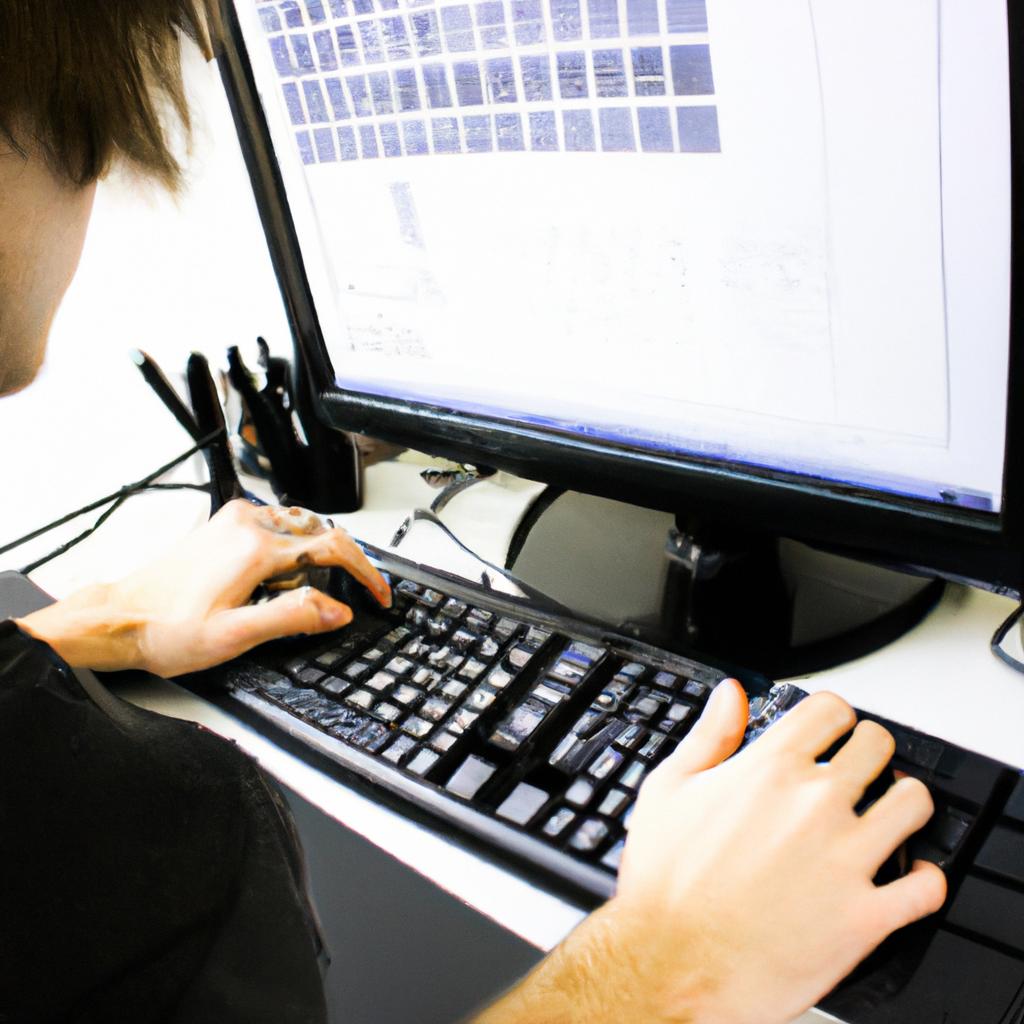Ray tracing is a fundamental technique in computer graphics processing that simulates the behavior of light to create realistic images. By tracing the path of each ray of light as it interacts with virtual objects and surfaces, ray tracing enables the generation of visually accurate scenes with complex lighting effects such as reflection, refraction, and shadows. For instance, consider a hypothetical scenario where an architect wants to visualize how natural sunlight will interact with different glass materials used in designing a skyscraper. Through the implementation of ray tracing algorithms, the architect can accurately simulate how light rays will bounce off various glass panels at different angles, providing valuable insights into both aesthetic and functional aspects of the building design.
With advancements in computational power and graphical hardware acceleration, real-time ray tracing has become increasingly feasible for interactive applications like video games and virtual reality experiences. This article aims to provide a comprehensive overview of ray tracing in graphics processing by exploring its underlying principles, techniques, and applications. Furthermore, it will discuss recent developments in hardware support for ray tracing and highlight challenges that researchers are currently addressing to improve performance efficiency. By understanding the fundamentals and potential benefits of this rendering method, designers, developers, and researchers can harness its capabilities effectively to enhance visual realism in their respective domains.
What is Ray Tracing?
Ray tracing is a powerful technique used in computer graphics to render realistic images by simulating the behavior of light. By tracing rays from the viewer’s eye through pixels on a virtual screen, ray tracing calculates how each ray interacts with objects in a scene, creating shadows, reflections, and refractions that closely resemble real-world lighting effects.
To better understand the concept of ray tracing, let’s consider an example. Imagine you are playing a video game set in a virtual forest. As you navigate through the dense foliage, sunlight filters through the leaves and casts intricate patterns of light and shadow on the ground below. With traditional rendering techniques, achieving such realistic lighting would be challenging. However, with ray tracing, each individual ray of light can be traced as it interacts with every leaf and branch along its path, resulting in stunningly lifelike visuals.
There are several key advantages associated with using ray tracing in graphics processing:
- Realistic Lighting: Unlike other rendering methods that rely on approximations or simplifications, ray tracing accurately models how light behaves in the physical world.
- Dynamic Reflections: Ray tracing enables dynamic reflections where objects reflect their surroundings realistically based on both their shape and material properties.
- Accurate Shadows: By precisely calculating how light rays interact with different objects within a scene, ray tracing produces accurate and detailed shadows.
- Refraction Effects: Ray tracing allows for precise modeling of transparent materials like glass or water by accurately representing their refractive properties.
| Advantages of Ray Tracing |
|---|
| Realistic Lighting |
In summary, ray tracing is a fundamental technique used in computer graphics to achieve highly realistic visual effects. By meticulously analyzing how light interacts with objects within a scene, this method provides accurate representations of lighting conditions that mimic those found in reality. In the following section, we will delve into the history of ray tracing in graphics to gain a deeper appreciation for its development and evolution.
[Continue reading: A Brief History of Ray Tracing in Graphics]
A Brief History of Ray Tracing in Graphics
Imagine a video game where the light reflects off every surface, creating realistic shadows and reflections that mimic real-world physics. This level of visual fidelity is made possible by ray tracing, an advanced technique used in graphics processing to simulate how light interacts with objects in a virtual environment. By tracing the path of individual rays of light as they interact with various surfaces, ray tracing can produce stunningly lifelike visuals that were once only imagined.
The advantages of ray tracing are numerous and have revolutionized the field of computer graphics. Here are some key benefits:
- Realistic Lighting: Ray tracing enables accurate simulation of global illumination effects such as soft shadows, reflection, refraction, and scattering. It takes into account multiple bounces of light between objects, resulting in scenes that look more natural and visually appealing.
- Enhanced Visual Quality: Compared to traditional rasterization techniques, which approximate lighting calculations using simplified algorithms, ray tracing provides superior image quality with precise rendering of complex lighting scenarios. This results in highly detailed images with improved depth perception and overall realism.
- Time Savings: While it may seem counterintuitive due to its computational complexity, modern hardware advancements and optimized algorithms have made real-time ray tracing feasible. With faster GPUs and dedicated hardware support for accelerating ray-triangle intersection tests, developers can achieve impressive visual effects without sacrificing performance.
- Artistic Freedom: Ray tracing empowers artists to create immersive digital worlds by accurately representing their vision through lifelike lighting models. They can experiment with different materials, textures, and environments while relying on ray tracing’s ability to faithfully reproduce their intended aesthetics.
| Realistic Lighting | Enhanced Visual Quality | Time Savings | |
|---|---|---|---|
| + | Soft Shadows | Precise Rendering | Real-time Performance |
| + | Reflection and Refraction | Improved Depth Perception | GPU Acceleration |
| + | Scattering Effects | Realism | Optimized Algorithms |
| + | Global Illumination | Lifelike Visuals |
In conclusion, ray tracing offers a range of advantages that have propelled the field of computer graphics forward. Its ability to simulate realistic lighting, enhance visual quality, save time through optimized algorithms, and provide artistic freedom has revolutionized the way virtual environments are rendered.
Transitioning seamlessly into the subsequent section about “Basic Principles of Ray Tracing,” let us now examine the foundational concepts underlying this groundbreaking technique.
Basic Principles of Ray Tracing
Section H2: Basic Principles of Ray Tracing
To understand the basic principles underlying ray tracing in graphics processing, let us consider a hypothetical scenario. Imagine we have a three-dimensional scene consisting of various objects such as spheres, cubes, and cylinders. The goal is to generate realistic images of this scene by simulating the behavior of light rays interacting with these objects.
One fundamental principle of ray tracing involves casting rays from a virtual camera into the scene. These rays are traced through each pixel of an image plane corresponding to the camera’s view. For instance, if we take a high-resolution image containing one million pixels, then one million primary rays need to be cast into the scene for rendering purposes.
Once these primary rays intersect with an object in the scene, secondary rays can be generated to determine how light interacts with that particular object’s surface. This process includes computing reflection and refraction effects accurately based on physical properties like material type and index of refraction. By considering multiple bounces of secondary rays within the scene, more realistic lighting effects can be achieved.
In summary, there are several key elements involved in ray tracing:
- Primary Rays: Cast from a virtual camera into the scene.
- Intersection Testing: Check where primary rays intersect with objects.
- Secondary Rays: Generated after intersections occur for accurate lighting calculations.
- Reflection and Refraction Effects: Simulate how light interacts with surfaces based on physical properties.
| Elements Involved in Ray Tracing |
|---|
| Primary Rays |
| Intersection Testing |
| Secondary Rays |
| Reflection and Refraction Effects |
Understanding these basic principles is crucial before delving deeper into advanced topics related to ray tracing techniques and optimizations. In the subsequent section about “Applications of Ray Tracing in Rendering,” we will explore how these principles are applied to various real-world scenarios, showcasing the versatility and potential impact of ray tracing technology.
Applications of Ray Tracing in Rendering
The basic principles of ray tracing lay the foundation for its numerous applications in rendering. By simulating the behavior of light rays and their interactions with objects in a scene, ray tracing offers remarkable capabilities to create realistic and visually stunning images. This section explores some key applications that leverage the power of ray tracing.
One notable application is in the field of architectural visualization. Architects and designers can use ray tracing techniques to generate photorealistic renderings of buildings and interiors before they are constructed. For instance, imagine an architect wants to showcase a new office building design to potential clients. With ray tracing, they can create detailed virtual models, accurately depicting how natural lighting will interact with different materials and textures within the space. This enables stakeholders to effectively visualize the final result, aiding decision-making processes.
In addition to architectural visualization, ray tracing has found wide-ranging usage in film production and special effects. It allows filmmakers to seamlessly integrate computer-generated elements into live-action footage by realistically simulating how light interacts between virtual objects and real-world environments. Consider a science fiction movie where alien creatures are added digitally during post-production. Through accurate shadowing and reflection calculations provided by ray tracing algorithms, these extraterrestrial beings can be convincingly integrated into scenes as if they were truly present on set.
- Enhanced realism: Ray tracing enables highly realistic simulations of complex lighting phenomena such as global illumination, soft shadows, reflections, refractions, and caustics.
- Time-saving workflows: The ability to accurately predict lighting conditions eliminates or reduces time-consuming trial-and-error iterations often required when using traditional rendering methods.
- Artistic control: Ray tracing gives artists precise control over every aspect of lighting within a scene, allowing them to achieve specific moods or atmospheres with ease.
- Immersive experiences: By realistically rendering lighting effects, ray tracing creates immersive virtual environments for applications like architectural walkthroughs or video games.
Furthermore, the table below summarizes some common applications of ray tracing in various industries:
| Industry | Application |
|---|---|
| Architecture | Photorealistic visualization |
| Film Production | Integration of CGI and live-action footage |
| Video Games | Real-time interactive rendering |
In summary, the applications of ray tracing extend beyond basic principles. Its usage ranges from architectural visualization to film production and video game development. With its ability to achieve enhanced realism, streamline workflows, offer artistic control, and create immersive experiences, ray tracing continues to revolutionize the field of computer graphics.
Transitioning into the subsequent section about “Challenges and Limitations of Ray Tracing,” it is crucial to acknowledge that while ray tracing has numerous benefits, there are also certain obstacles and constraints that need to be addressed.
Challenges and Limitations of Ray Tracing
Section 3: Challenges and Limitations of Ray Tracing
While ray tracing has proven to be a powerful tool in rendering realistic images, it is not without its challenges and limitations. Understanding these constraints is crucial for researchers and developers striving to overcome them and further improve the technology.
One significant challenge faced by ray tracing algorithms is the computational complexity involved in simulating the behavior of light rays accurately. The process requires casting numerous rays into a scene, intersecting them with objects, calculating reflections and refractions, and determining their contributions to the final image. This extensive computation can be demanding even for modern graphics processing units (GPUs) or dedicated hardware accelerators.
Additionally, real-time applications that require interactive frame rates pose another hurdle for ray tracing techniques. Due to the time-consuming nature of accurate ray-object intersection calculations, achieving high frame rates becomes challenging when dealing with complex scenes containing multiple geometry elements. Although advancements such as bounding volume hierarchies and spatial data structures have been introduced to accelerate this process, there are still limitations on how fast real-time ray tracing can operate.
Moreover, despite recent progress made in optimizing performance, memory usage remains a concern for large-scale scenes. Storing geometry information and acceleration structures efficiently while minimizing memory access overheads presents ongoing research challenges. Techniques like level-of-detail representations and out-of-core methods have emerged to tackle this problem but often come at the cost of increased storage requirements or additional preprocessing steps.
In summary, while ray tracing offers compelling advantages in generating photorealistic images, several challenges persist in its adoption for real-time applications due to computational complexity, real-time performance requirements, and memory usage concerns.
Moving forward into future developments in ray tracing technology, researchers continue to explore innovative solutions aiming to address these limitations effectively. By leveraging advancements in hardware capabilities such as specialized GPU architectures designed specifically for ray tracing operations combined with clever algorithmic optimizations, new possibilities emerge towards achieving faster rendering speeds without compromising quality. The subsequent section will delve into these exciting prospects for the future of ray tracing technology.
Now, let’s move on to explore the advancements and potential future developments in ray tracing technology.
Future Developments in Ray Tracing Technology
Transitioning from the challenges and limitations of ray tracing, it is evident that significant advancements have been made in recent years to overcome these obstacles. One notable example is the implementation of real-time ray tracing in video games. This breakthrough has revolutionized the gaming industry by providing a more immersive and realistic visual experience for players.
To further illustrate the progress in ray tracing technology, consider the following key developments:
- Hardware Acceleration: The introduction of specialized hardware components, such as dedicated ray tracing cores and tensor cores, has greatly enhanced the performance of ray tracing algorithms. These accelerators enable faster intersection calculations and improve overall rendering efficiency.
- Algorithmic Improvements: Researchers have focused on developing novel algorithms to optimize various aspects of ray tracing, including acceleration structures like bounding volume hierarchies (BVH) or kd-trees. By utilizing advanced data structures and traversal techniques, ray tracing computations can be significantly accelerated.
- Hybrid Rendering Techniques: To strike a balance between computational cost and visual quality, hybrid rendering approaches combine traditional rasterization with ray tracing methods. This integration allows developers to leverage both approaches’ strengths while minimizing their respective weaknesses.
- Machine Learning Applications: Artificial intelligence-based techniques have been applied to enhance different stages of the rendering pipeline, including denoising and upscaling low-resolution images generated through ray tracing. These machine learning models help produce visually appealing results while reducing computation time.
The impact of these advancements cannot be overstated; they have paved the way for exciting possibilities in various industries beyond gaming alone. A comparative analysis highlighting some key attributes relevant to decision-making processes employing either rasterization or ray-tracing techniques is presented below:
| Rasterization | Ray Tracing | |
|---|---|---|
| Realism | Limited lighting effects | Accurate global illumination |
| Shadows | Simple shadow maps | Soft shadows with precise light interactions |
| Reflections | Screen-space reflections | Accurate and realistic reflections |
| Complexity | Suitable for real-time rendering | More computationally intensive |
As evident from the table, ray tracing offers a more visually appealing and accurate representation of scenes compared to traditional rasterization techniques. These advancements have opened up opportunities for various industries such as architecture, film production, and virtual reality.
In summary, significant progress has been made in advancing ray tracing technology. The integration of hardware acceleration, algorithmic improvements, hybrid rendering techniques, and machine learning applications has resulted in more immersive visual experiences across multiple domains. As researchers continue to innovate in this field, we can expect further developments that push the boundaries of realism and computational efficiency even further.



